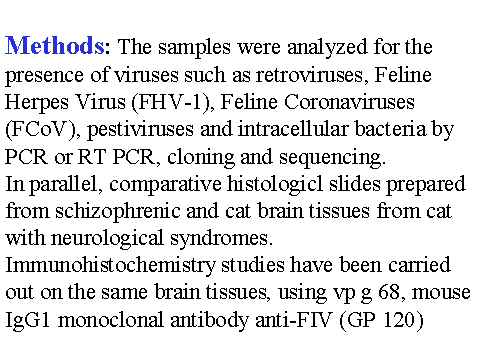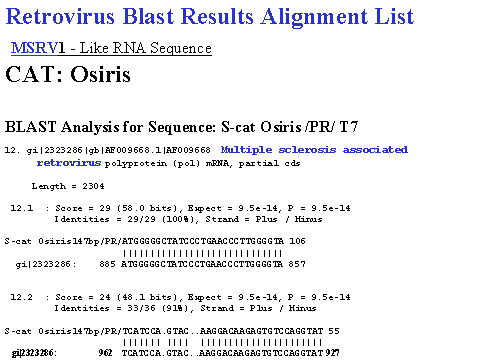PRELIMINARY EVALUATION OF VIRUSES AND
INTRACELLULAR BACTERIA STATUS IN URBAN CATS AND THEIR RELATIONSHIP WITH
DEVELOPMENT OF SCHIZOPHRENIA IN HUMAN
Reza Firouzi
Background: The scientists (EF
Torrey and RH Yolken, 1995), following their epidemiological studies have
presented the theory and the hypothesis, suggesting the role of domestic cats in
development of schizophrenia (SCZ) in humans. Cats are well known carriers
of infectious agents such as viruses, bacteria and parasites responsible for
anthropozoonoses and their transmission could eventually be a risk factor for
the development of SCZ and bipolar disorder in humans.
Materials: Around 60 cat’s sera,
and 34 cat’s brain samples from the Veterinary School of Lyon, France and some
private clinics, as well as 15 schizophrenic, 2 negative sera, 2 series of 10
schizophrenic brain blocks frozen and fixed cortex (parietal – occipital) and 10
brain blocks frozen cerebellum of the same individuals, as well as 5 normal
control brain tissues from the same regions and at the same conditions were
provided by Stanley Medical Research Foundation, Bethesda, MD.
Methods: The samples were
analyzed for the presence of viruses such as retroviruses, Feline Herpes Virus
(FHV1), Feline Coronaviruses (FCoV), pestiviruses and intracellular bacteria by
PCR or RT-PCR, cloning and sequencing. In parallel, comparative
histological slides prepared from schizophrenic and cat brain tissues from cats
with neurological syndromes. Immunohistochemistry studies have been carried out
on the same brain tissues, using vp g 68 mouse IgG1 monoclonal antibody anti-FIV
(GP120) and polypesti, oligoclonal-antibody (mixture of murine monoclonal
antibodies) directed against structural gp 48 gp 62 and non-structural p- 80-125
of BVD-MD, BD and HCV strains. E. microscopy studies were carried out on
10 SCZ, 3 normal tissues (from the parietal-occipital) and 4 cat brain fixed
tissues and after post staining (lead citrate and uranyle acetate) were examined
at the E. microscopy center of the Laennec Medicine Faculty, Lyon, France.
Results: The retroviral sequences
related to Multiple Sclerosis Associate Retrovirus (MSRV) were detected in 1/15
SCZ and 3/4 cat sera. Partial retroviral sequences related to mesocricetus
auratus retrovirus have been detected in 2/15 SCZ and 3/40 cat sera.
Expected band was obtained after DNA amplification from the FHY1 Thymidine
Kinase (tk) sequences, in 2/7 SCZ sera, but following sequencing of numerous
clones, only human genomic DNA could be detected between the up and downstream
tk oligo primers. No pestivirus or coronavirus could be detected in 15 SCZ
sera, 10 SCZ brain tissues, 60 cat sera and cat brain tissues analyzed.
The research for intracellular bacteria was negative but only two types of gram
negative bacteria (stenotrophomonas maltophilia, and a plant root nodule
bacteria) sequences could be detected in 2/15 SCZ sera tested. No specific
staining on feline or human tissues could be observed following
immunohistochemistry studies. Following EM studies, a few number of probably
defective virus like particles with double membrane and dense nuclide as well as
some type of bacteria have been observed in some of the grids examined.
Discussion: These preliminary
results may be encouraging for carrying out our studies on more specimens.
The presence of retroviral sequences related to MSRV in some of the SCZ patients
have previously been detected and discussed by the scientists collaborating with
Stanley Research Foundation. The presence of the same sequences in some
cats may need further studies on more cat specimens for a correct conclusion,
but it should be worthwhile to mention that, MSRV has recently been demonstrated
to have very close homology with Baboon endogenous retrovirus, which originally
belongs to the feline family. The presence of mesocricetus auratus
retroviral (already isolated in CNS diseases) sequences both in SCZ and cat
specimens, might be another risk factor for developing schizophrenia, which
should be studied on a greater number of specimens.
Poster:
 |
 |
